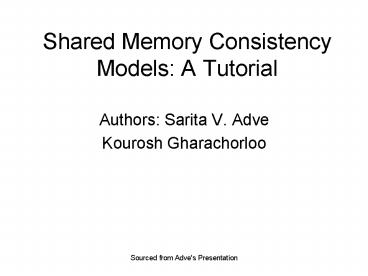Shared Memory Consistency Models: A Tutorial - PowerPoint PPT Presentation
1 / 20
Title:
Shared Memory Consistency Models: A Tutorial
Description:
Shared Memory Consistency ... appear to execute in program order SC implies Cache Coherence: A memory consistency model as the policy that places an early and ... – PowerPoint PPT presentation
Number of Views:227
Avg rating:3.0/5.0
Title: Shared Memory Consistency Models: A Tutorial
1
Shared Memory Consistency Models A Tutorial
- Authors Sarita V. Adve
- Kourosh Gharachorloo
2
Overview
- Memory Consistency Model
- Implicit Memory Model -- Sequential Consistency
- Relaxed Memory Model (system-centric)
- Relaxed models (program-centric)
3
Memory Consistency Model
- Definition Order in which memory operations will
appear to execute - -- what value can a read return
- -- a read should return the value of the last
write to the same memory location - Affecting 3P
- -- Programmability (easy-of-programming)
- -- Performance (optimization)
- -- Portability (moving software across different
systems)
4
Implicit Memory Model
- Sequential consistency (SC) Lamport
- Result of an execution appears as if
- All operations executed in some sequential order
- Memory operations of each process in program
order
5
Implicit Memory Model
- Sequential consistency (SC) Lamport
- Result of an execution appears as if
- All operations executed in some sequential order
- Memory operations of each process in program
order
Two aspects Program order Atomicity
6
Architectures without Caches example 1
- Initially Flag1 Flag2 0
- P1 P2
- Flag1 1 Flag2 1
- if (Flag2 0) if (Flag1 0)
- critical section critical section
- Execution
- P1 P2
- (Operation, Location, Value)
(Operation, Location, Value) - Write, Flag1, 1 Write, Flag2, 1
- Read, Flag2, 0 Read, Flag1, ____
7
Architectures without Caches example 1
- Initially Flag1 Flag2 0
- P1 P2
- Flag1 1 Flag2 1
- if (Flag2 0) if (Flag1 0)
- critical section critical section
- Execution
- P1 P2
- (Operation, Location, Value)
(Operation, Location, Value) - Write, Flag1, 1 Write, Flag2, 1
- Read, Flag2, 0 Read, Flag1, 0?
8
Architectures without Caches example 1
P1 P2 (Operation, Location, Value)
(Operation, Location, Value) Write, Flag1, 1
Write, Flag2, 1 Read, Flag2, 0 Read,
Flag1, 0
Can happen if Write buffers with read
bypassing Overlap, reorder write followed by
read in h/w or compiler Allocate Flag1 or Flag2
in registers Optimization by use of writer
buffer is safe on convention uniprocessor, but it
can violate SC in multiprocessor system.
9
Architectures without Caches example 1
Write buffer
10
Architectures without Caches example 2
Initially Head Data 0 P1 P2 Data
2000 while (Head ! 1) Head 1
... Data P1 P2 Write, Data, 2000
Read, Head, 0 Write, Head, 1 Read,
Head, 1 Read, Data, 0?
Can happen if Overlap or reorder writes or
non-blocking reads in hardware or compiler
11
Architectures without Caches example 2
Overlapped writes
12
Architectures without Caches example 3
Non-blocking reads
13
Architectures With Caches
- Cache Coherence and SC
- Cache Coherence
- A write is visible to all processors
- Serialization of writes to the same location
- SC
- Serialization of writes to all locations
- Operations appear to execute in program order
- SC implies Cache Coherence
- A memory consistency model as the policy that
places an early and late bound on when a new
value can be propagated by invalidating or
updating - Atomicity for writes
- Propagating changes to cache copies in a
non-atomic operation - Serialize write can avoid the violation of SC
- Ordering of updates/invalidates between source
and destination is preserved by network - Or delay an update/invalidate from being sent out
until any updates or invalidates from previous
write are acknowledged
14
SC Summary
- SC constrains all memory operations
- Write ? Read
- Write ? Write
- Read ? Read, Write
- Simple model for reasoning about parallel
programs - But, intuitively reasonable reordering of memory
operations in a uniprocessor may violate
sequential consistency model in multiprocessor - Modern microprocessors reorder operations all the
time to obtain performance (write buffers,
overlapped writes,non-blocking reads). - How do we reconcile sequential consistency model
with the demands of performance?
15
Relaxed Memory Model
- Optimizations
- Program order relaxation
- Write ? Read
- Write ? Write
- Read ? Read, Write
- Read others write early
- Read own write early
16
Relaxed Memory Model (system-centric)
Models provide safety net Models maintain
uniprocessor data and control dependences, write
serialization
17
System-Centric model assessment
- System-centric models provide higher performance
than SC - BUT how about 3P criteria
- Programmability?
- Programmer need to consider the correctness with
the optimization the specific model provides - Portability?
- Many different models
- Performance?
- Can we do better?
- Programmer-Centric Model
18
Programmer-Centric Models
- Data operation executed more aggressively
- Programmer provide information about memory
operations - System based on the model exploit the
optimization without violating consistency
19
Programmer-Centric Model
20
Programmer-Centric Model Assessment
- 3P criteria
- Programmability
- System ensure correctness instead of safety nets
used by programmer - Performance
- Optimization enabled by the WO can be applied
- Information enables more aggressive optimization
- Portability
- Not based on specific model































